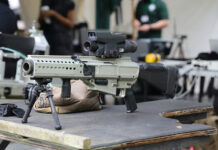The Macro-Composite Protection System (MAPS) armor, developed by Lockheed Martin provides protection against multiple hits of armor-piercing rifle bullets and high-speed fragments from improvised explosive devices (IEDs). Other applications to be pursued by MAPS’ developers include protection against hand grenades, mines and other battlefield threats.
MAPS is designed as an “armor-as-a-system”, developed in an attempt to counter several threat effects often encountered in today’s urban tactical environments, such as a bomb blast followed by a swarm of projectiles or armor-piercing sniper fire. MAPS armor is made out of a Lockheed Martin-developed macro-composite material encased in shock-absorbing polymers with a metallic strike face and spall plate. In recent testing, MAPS successfully stopped four successive shots of 7.62mm armor-piercing bullets striking at high velocity within a four-inch diameter circle.
According to David Hunn, director – Mechanical Engineering at Lockheed Martin Missiles and Fire Control, “MAPS armor promises to provide an entirely new level of vehicle and personal protection to our forces that could save lives. And it should prove much less expensive than current ceramic armors once in production.” The new material is undergoing ballistic testing and has successfully shown protection against realistic armor piercing and fragmentation threats with no penetration, at a weight approximately 50 percent less than its equivalent in steel armor protection. Typical composites weigh about 60% of an equivalent steel armor. MAPS armor samples have already been delivered to U.S. armed services for independent testing. Results of those tests should be available later this year.
















